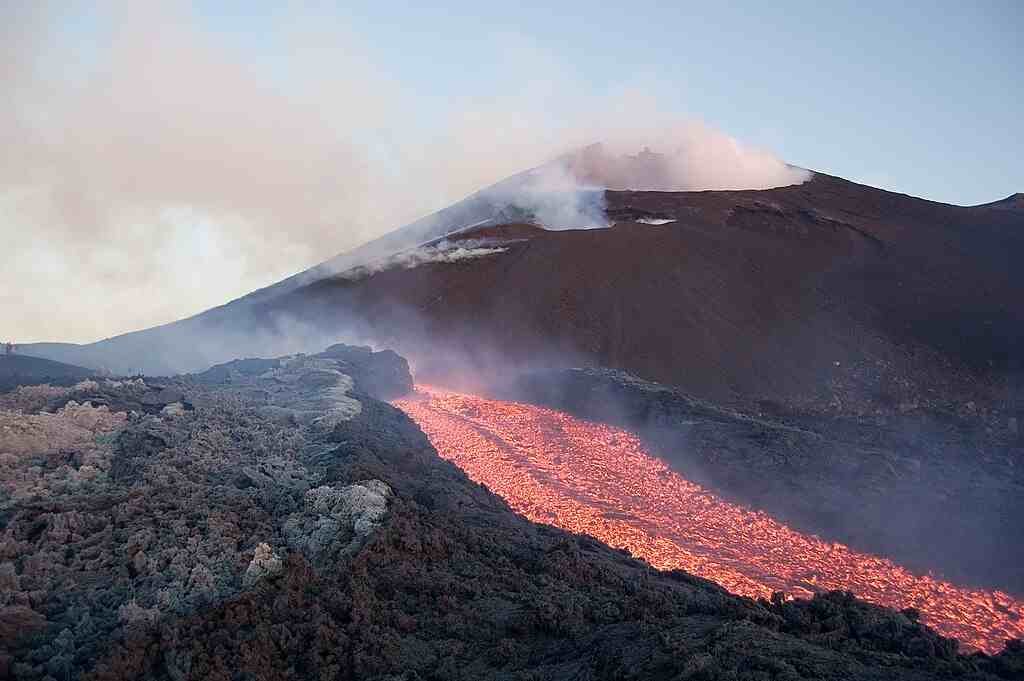How Was Mount Etna formed?
Mount Etna, which fascinates us with its frequent eruptions, is associated with a complex tectonic context, linked to the subduction of the African plate under the Eurasian plate. How was mount Etna formed?
Mount Etna is certainly the most famous volcano in Europe. Located in Sicily, it is one of the most active volcanoes in the world with nearly 80 eruptions during the last century. It currently culminates at 3 357 meters (11 013 ft) above the sea level, making it the highest volcano in Europe.
It is classified as a red volcano because of its effusive eruptions (eruption in the form of lava melting through the cracks found in the body of the volcano). Etna emits large quantities of very fluid lava, which can be accompanied by large-scale explosions. We are talking about Strombolian type eruptions. Mount Etna is a complex volcano, made up of several craters. This huge volcanic edifice is actually made up of several volcanoes that have grown on top of each other.
The volcanism of Etna, like that of the Aeolian Islands, would be associated with a process of subduction, although in detail everything is not so clear.
 On the slopes of Etna. René Hourdry, CC BY-SA 4.0, via Wikimedia Commons
On the slopes of Etna. René Hourdry, CC BY-SA 4.0, via Wikimedia Commons
A complex tectonic context
The Mediterranean Sea is indeed a real tectonic puzzle. In this region, the confrontation between two large tectonic plates is played out: the African plate and the Eurasian plate. It is this confrontation that notably gave birth to the Alps. In the region of Sicily, the African plate enters into subduction and sinks under the Eurasian plate.
Currently, the convergence speed is 5 mm/year and gives rise to regular seismicity. This subduction zone (the area where two plates meet that form a series of volcanoes and earthquakes) has also generated several major earthquakes in the past, such as the earthquake of 1693, of magnitude Mw 7.3 or the earthquake of 1905, of magnitude Mw 7.0. The high population density of the region makes it a high seismic risk zone, particularly threatened by tsunamis.
However, subduction zones also generate intense volcanism behind the subduction pit, giving rise to very active volcanoes. We speak of arc volcanism. The volcanoes forming the Aeolian Islands, such as Stromboli and Vulcano, are clearly associated with a volcanic arc. This series of volcano is located north of Sicily. In comparison, the origin of Etna’s lavas is less obvious and remains debated because the volcano is not located directly above the plane of subduction. The volcanism of Etna could in particular be associated with a rift zone (extension), a hot spot or the presence of a fracture in the crust allowing the transport of magma from a more distant source. associated with the subduction zone.
Read also: Bromo Tengger Semeru-Arjuno National Park in East Java, Indonesia
Formation of the volcanic edifice
The first eruptions of Etna have been dated over 500,000 years ago. At this time, the volcano in formation was submerged and located in the basin located at the level of the subduction pit. 300,000 years ago, data show that the formation of a basaltic volcanic plateau at the level of the alluvial plain of the Simento River. Volcanic activity intensified 220,000 years ago with the initiation of a context of tectonic extension. This phase led to the formation of a shield volcano, characterized by very fluid lava. The building is then rather elongated, with a flat cone.
Gradually, volcanic activity concentrated on the central part of the shield, at the level of the current position of the volcano. This location has allowed the construction of several successive stratovolcanoes. Etna’s magmatic system stabilized in its current architecture about 60,000 years ago.
The growth of Etna has notably been interrupted episodically by explosions causing the collapse of its caldera, as in 122 BC. Currently, the summit is composed of five craters, which appeared in 1911, 1947, 1968, 1971 and 2007. Today mount Etna is still active.
Etna Volcano and Summit Craters | UNESCO World Heritage | How to visit Etna?
Sources: PinterPandai, Geology, Britannica
Photo credit: Author: Romgiovanni at Italian Wikipedia (CC BY-SA 3.0) via Wikimedia Commons
Description: volcano Etna (Sicily, Italy) during an eruption 2006.



